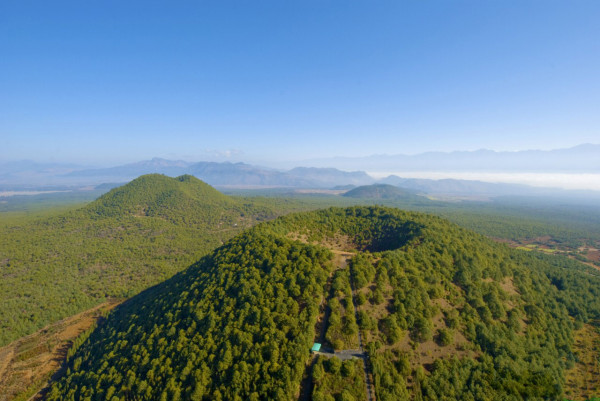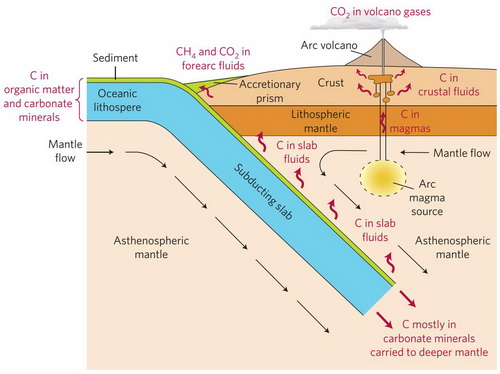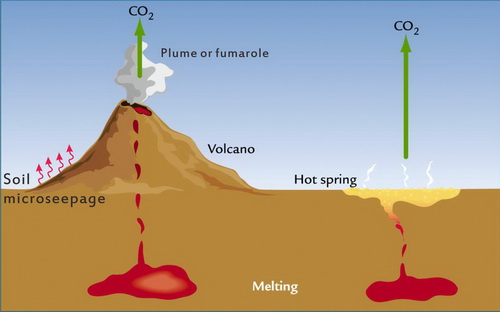
Tengchong Volcanic Geological Park in Yunnan (Image: Baidu.com)
Deep carbon cycling at subduction zones plays an important role in modulating the CO2 concentration in Earth’s atmosphere and is vital to understanding geological carbon emissions and greenhouse effects. Previous studies have mainly focused on CO2 fluxes of oceanic subduction zones (Fig. 1), but our knowledge remains limited on CO2 emissions of continental subduction zones. Prof. GUO Zhengfu's research group at the Key Laboratory of Cenozoic Geology and Environment (KLCGE), Institute of Geology and Geophysics, Chinese Academy of Sciences (IGGCAS) found that magma-derived CO2 emissions from the Tengchong active volcanic field, SE Tibet, has the potential to reveal the mechanisms of the deep carbon cycle at the India-Asia continental subduction zone. This work was published in Journal of Asian Earth Sciences.
For an active volcano, CO2 can be released into the atmosphere during both eruptive and quiescent stages in forms of eruptions and diffusive degassing (including fumaroles, bubbling hot springs and soil microseepage; Fig. 2), respectively. In the context of global warming, great attention has been paid to the contribution of CO2 emissions from active volcanoes to global carbon budget. Active volcanoes in the Tengchong volcanic field of SE Tibet are an excellent window for insights into deep carbon flux and the genesis of volatiles released from the India-Asia continental subduction zone.
Under the guidance of Prof. GUO Zhengfu, graduate student ZHANG Maoliang carried out a soil CO2 flux survey using accumulation chamber method and portable soil CO2 flux meter. On the basis of CO2 fluxes from hot springs and soil microseepage, total CO2 output of the Tengchong volcanic field is estimated at (4.48–7.05) × 106 ton per year, which would add new data from active volcanoes in China to global volcanic subaerial CO2 flux (5.40 × 108 ton per year). Systematic studies on magma-derived CO2 fluxes from typical active volcanoes (such as Changbaishan, Tengchong and Wudalianchi) are ongoing and aim to evaluate the scale of CO2 emissions from active volcanic fields in China.
He-C isotope coupling model suggests involvement of recycled organic metasediments and limestones from subducted Indian continental lithosphere in formation of the enriched mantle wedge (EMW), which has been recognized as source region of the TVF parental magmas. Contamination by crustal limestone is the first-order control on variations in He-CO2 systematics of volatiles released by the EMW-derived melts. It is proposed that mantle-derived magmas at continental subduction zones can act as important triggers for the liberation of carbon stored in crustal carbonate rocks, which would contribute to understanding of the mechanisms controlling deep carbon cycling at the India-Asia continental subduction zone.
The study was in collaboration with Prof. Yuji Sano of University of Tokyo. The work was supported by the National Natural Science Foundation of China (Grant No. 41572321), the Strategic Priority Research Program (B) of Chinese Academy of Sciences (Grant No. XDB03010600), and a project from the Chinese Ministry of Science and Technology (Sinoprobe-05-03).

Figure 1: Deep carbon cycle at subduction zone (Manning, 2014)

Figure 2: Types of CO2 emissions from an active volcano (modified from Ruddiman, 2008)
Contact:
GUO Zhengfu
Institute of Geology and Geophysics, Chinese Academy of Sciences
Phone: 86-10-82998393
E-mail: zfguo@mail.iggcas.ac.cn